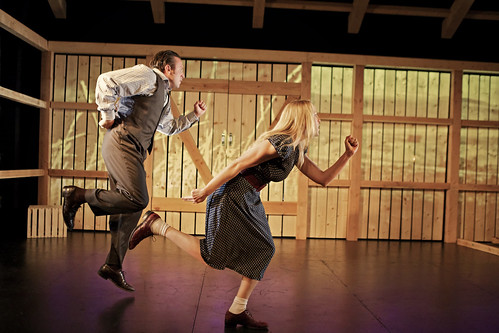Bonnie & Clyde live (and die) by the Shotgun (Players)
 Megan Trout is Bonnie and Joe Estlack is Clyde in Shotgun Players' production of Bonnie & Clyde by Adam Peck. Below: One of the intriguing dance/movement interludes in the 80-minute show. Photos by Pak Han
Megan Trout is Bonnie and Joe Estlack is Clyde in Shotgun Players' production of Bonnie & Clyde by Adam Peck. Below: One of the intriguing dance/movement interludes in the 80-minute show. Photos by Pak Han
Somehow it seems entirely appropriate that Berkeley's Shotgun Players are reviving the myth of gangsters Bonnie and Clyde. The celebrated criminals storm the Ashby Stage on the run from the law and nearing the end of their bloody, well-chronicled run of robberies and murders across the American south. They enter an abandoned barn to take cover. He's got a pistol in each hand and she's wielding -- what else? -- a shotgun. She is, it turns out, a true shotgun player.
British playwright Adam Peck's stage version of the Bonnie and Clyde story is not really anything like the revered 1967 movie version except for the basic facts of the story: Clyde Barrow and Bonnie Parker, the head of what came to be known as the Barrow Gang embark on a series of crimes in Texas and Oklahoma spanning 1932 to '34. They became the darlings of the media, and their run came to an end when they were killed in a hail of bullets in a northern Louisiana ambush.
Peck's Bonnie & Clyde takes place the night before that ambush as the weary lovers hide out in a barn and take stock of their situation and each other. What's so interesting about this piece, especially in the hands of a gifted director like Mark Jackson, is that the text almost becomes secondary to tone of the piece, which is more performance art than play, incorporating dance, soundscape and video projections. It's a Bonnie and Clyde story by way of art installation, and it's gorgeous.
The design team, including Robert Broadfoot (set), Ashley Rogers (costumes), Micah Stieglitz (projections), Matt Stines (sound) and Jon Tracy (lights) do stunning work here, creating one ravishing stage picture after another as the traditional play in which Bonnie and Clyde fret and fight is interrupted by compelling moments of fantasy and dance and foreboding (several of Clyde's interludes describe in detail the massacre that will happen the next day).
The choreography, created by Kimberly Dooley along with director Jackson and actors Megan Trout and Joe Estlack, ranges from modern dance to Fred-and-Ginger charm (Bonnie and Clyde's song, we're told, was "Cheek to Cheek") to death by gunfire as interpretive dance. These compelling interludes are almost more powerful than the script itself because Estlack and Trout are so compelling, so powerful in their movements, especially in partnership. This is a sexy Bonnie and Clyde, which seems appropriate, and that sense of titillation comes with guilt. How can cold-blooded murderers be sexy? Therein lies the conundrum of the real-life Bonnie and Clyde, the romantic Robin Hood-like figures who etched such a permanent mark on the American psyche.
Not to discount Peck's script, which has its own intriguing complexity as we try to figure out the nature of Bonnie and Clyde's relationship. She seems much more invested than he, at least physically, but there's no question that they're deeply bonded to one another. Part of that bond involves the undeniable thrill of being famous outlaws. They love being in the limelight. Bonnie even imagines herself a star of the vaudeville stage (shades of Chicago here), while Clyde, who's perturbed that a newspaper has attributed a murder to him that he did not commit, is somewhat mollified when Bonnie, who calls him Daddy, points out how handsome the photo is that accompanies the article.
You do feel some sympathy for these people and for the way their spree has spiraled out of control. They know full well how it will all end (they don't know it will be tomorrow), and they're somewhat resigned to that, which lends dramatic weight to their tragic love story. In Peck's version, Clyde is not a maniac killer but rather someone who takes killing seriously (as opposed to lightly) and would rather not do it.
At only 80 minutes, Bonnie & Clyde can't paint a full picture, but we learn enough to know that these young people were in way over their heads, and it's actually painful to see the newsreel footage of the real Bonnie and Clyde as shot-up corpses. What was the point of it all? Fame? Well, they got that -- more than they ever could have realized. And what do we make of them? Inevitable off-shoots of the American dream of fame, riches and rising above humble beginnings? If you can't earn it honestly, you can shoot your way to it. The real American dream.
[bonus interview]I interviewed playwright Adam Peck and director Mark Jackson about Bonnie & Clyde for the San Francisco Chronicle. Read the story here.
FOR MORE INFORMATIONAdam Peck's Bonnie & Clyde continues through Sept. 29 at Shotgun Players' Ashby Stage, 1901 Ashby Ave., Berkeley. Tickets are $20-$35. Call 510-841-6500 or visit www.shotgunplayers.org for information.
